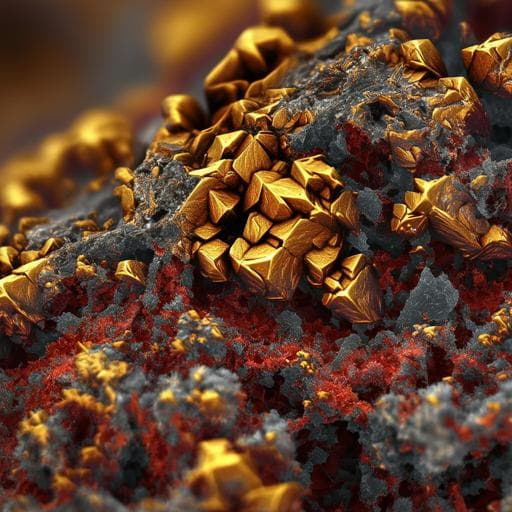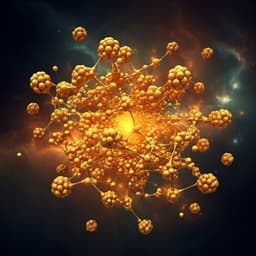
Earth Sciences
Transport and coarsening of gold nanoparticles in an orogenic deposit by dissolution-reprecipitation and Ostwald ripening
E. C. G. Hastie, M. Schindler, et al.
Explore the intriguing role of gold nanoparticles in the formation of high-grade zones within the Kenty orogenic gold deposit in Ontario, Canada. This research, conducted by E. C. G. Hastie, M. Schindler, D. J. Kontak, and B. Lafrance, reveals innovative insights using cutting-edge technology.
~3 min • Beginner • English
Introduction
Orogenic gold deposits are major global Au resources and commonly host spectacular high-grade zones with coarse gold. Conventional Au-in-solution models struggle to fully account for the formation of such coarse, high-grade gold, prompting consideration of alternative mechanisms including nanoparticle transport and aggregation. While nanoparticle-related processes have been documented primarily in epithermal, Carlin, and seafloor massive sulfide systems, their role in secondary remobilization typical of orogenic deposits has remained unproven. This study investigates whether gold nanoparticles participate in remobilization and coarsening of gold at the Kenty orogenic deposit (Abitibi greenstone belt, Ontario), where earlier work indicates late coarse gold formed by dissolution–reprecipitation of auriferous pyrite and possible involvement of low-melting-point chalcophile element (LMCE)-rich polymetallic melts. The purpose is to directly document gold nanoparticles, their mineral associations, and coarsening textures, and to evaluate mechanisms (e.g., non-oriented attachment, Ostwald ripening) by which nanoparticles could upgrade ore zones.
Literature Review
Prior studies have identified nanoparticulate and colloidal gold as key contributors to high-grade ('bonanza') mineralization in epithermal environments and in Carlin-type and seafloor massive sulfide deposits. Evidence includes direct imaging of Au nanoparticles in pyrite, colloidal transport signatures, and diffusion-limited aggregation textures. In contrast, orogenic settings have lacked direct observations of nanoparticle involvement in secondary remobilization. Concurrently, experimental and field data support LMCE (e.g., Bi-Te) polymetallic melts concentrating Au in the presence of hydrothermal fluids. Nanoparticle behavior is governed by surface charge, pH, counter-ion adsorption, and size-dependent properties (e.g., melting temperature depression and stability), yet conditions pertinent to ore-forming systems (e.g., the pH of point of zero charge at elevated temperatures) remain poorly constrained. This study builds on that literature by seeking direct nanoscale evidence in an Archean orogenic deposit and by assessing nanoparticle coarsening mechanisms distinct from those inferred in epithermal systems.
Methodology
Field sampling and mapping targeted the Kenty deposit high-grade assemblage. A mineralized sample containing early Au-bearing pyrite (~800 ppm Au) spatially associated with late coarse native gold was selected. Focused ion beam (FIB) sections were extracted using an FEI Helios 650 NanoLab and thinned to electron transparency with Ga ion milling, including lifts with a Pt gas-glue. Sections were taken from the interior of a pyrite grain and across its interface with adjacent gold–hematite–albite–rutile. Transmission electron microscopy (TEM) and scanning TEM (STEM) with EDS were performed on an FEI Talos F200X at 200 kV, employing bright-field and high-angle annular dark-field imaging, four SDD detectors for compositional mapping, and selected area electron diffraction (SAED) and fast Fourier transforms (FFT) for phase identification. SEM-EDS (Zeiss EVO 50 with Oxford X-Max 50 mm² EDS, 20 kV, 750 pA, 8.5 mm WD) provided micro-scale imaging. Quality control included monitoring for FIB artifacts and beam damage: sequential STEM/TEM imaging before, during, and after EDS mapping (up to 30 min acquisitions) showed no changes in nanoparticle number, morphology, or texture beyond sample drift. Interpretation of phases relied on diffraction patterns, chemical maps, semi-quantitative analyses, and textural context. Geological and regional context were compiled from prior mapping and geochronology.
Key Findings
- Direct nanoscale evidence of gold nanoparticles is documented in an Archean orogenic deposit (Kenty). Nanoparticles occur: (a) as Au–Ag–Te–Pb droplet-like nano-domains within pyrite; (b) as 1–5 nm Au nanoparticles within Fe oxides (hematite, goethite, magnetite/maghemite) adjacent to gold; and (c) as up to ~10 nm Au nanoparticles within rutile near gold surfaces.
- Gold nanoparticles are present in Fe-oxides coating coarse gold surfaces; high-resolution TEM/FFT shows the nanoparticles have lattice orientations different from the host gold, evidencing non-oriented attachment.
- Textures indicate gold coarsened by non-oriented attachment followed by dissolution of nanoparticles and mass transfer of Au monomers to larger gold (Ostwald ripening), rather than oriented attachment-driven dendritic growth typical of some epithermal systems.
- The observed Fe-oxide assemblage (coexisting Fe2+, Fe3+, and hydrous phases) and three-dimensional nanoparticle occurrences argue against FIB redeposition artifacts.
- Early auriferous pyrite (hundreds to thousands of ppm Au; sample ~800 ppm Au) underwent dissolution–reprecipitation by an oxidizing fluid, liberating Au that was transported as nanoparticles. Charge-dependent transport and aggregation are plausible under pH fluctuations relative to gold’s point of zero charge (PZC ~3 at 25 °C) and via counter-ion (e.g., Fe3+) adsorption.
- Nanoparticle sizes and hosts suggest matrix-dependent thermal stability: Au NPs <4 nm are unstable in pyrite at orogenic temperatures (250–400 °C) but are preserved in Fe-oxides and rutile; Kenty minimum temperatures ~335 °C.
- Evidence for polymetallic Au–LMCE nano-droplets and previous work on fluid-mediated LMCE melts indicate both nanoparticle transport and polymetallic melts can contribute to Au upgrading; where LMCE phases are absent, nanoparticle transport may dominate.
- Geological context: Swayze area (AGB) rocks deposited/emplaced ca. 2750–2670 Ma; metamorphic T ~350–450 °C, P ~3 kbar. Late coarse gold lines fractures cutting quartz veins near altered basalts and granitoids (U–Pb zircon 2684.7 ± 1.5 Ma).
Discussion
The study addresses the long-standing question of whether nanoparticle processes operate during secondary remobilization in orogenic gold systems. By imaging Au nanoparticles in pyrite, Fe-oxides, and rutile and documenting non-oriented attachment to coarse gold, the work demonstrates that oxidizing fluid-mediated dissolution–reprecipitation of auriferous pyrite can liberate gold that is transported as nanoparticles and subsequently coarsens via Ostwald ripening. The charge-dependent transport framework (influenced by pH relative to the gold PZC and counter-ion adsorption) explains how nanoparticles remain suspended and then aggregate near reactive mineral interfaces (e.g., albitization raising pH or Fe3+ adsorption canceling negative surface charges). These findings reconcile the presence of high-grade coarse gold in zones lacking LMCE phases by invoking nanoparticle transport and coarsening as an alternative or complementary mechanism to LMCE-rich polymetallic melts. The recognition that coarsening mechanisms differ between orogenic (non-oriented attachment, Ostwald ripening) and epithermal (diffusion-limited, oriented attachment) settings refines genetic models for high-grade ore formation and informs exploration targeting of reactive mineral assemblages and alteration fronts that modulate pH and counter-ions.
Conclusion
This work provides direct evidence that gold nanoparticles participate in remobilization and coarsening of gold in an Archean orogenic deposit. Nanoparticles occur in pyrite, Fe-oxides, and rutile and exhibit non-oriented attachment to coarse gold, consistent with coarsening via Ostwald ripening. Together with prior evidence for LMCE polymetallic melts, the results indicate that both nanoparticle transport and fluid-mediated melts can upgrade Au deposits, with nanoparticle processes potentially dominating where LMCE phases are absent. The study expands nanoparticle-related mechanisms beyond epithermal and Carlin systems to orogenic deposits across geologic time.
Future research directions include: (1) quantifying the role of Ag in Au nanoparticle behavior (most natural Au contains significant Ag); (2) establishing whether Au in precursor pyrite converts to nanoparticles or is liberated as such during dissolution; (3) defining relationships among Au nanoparticles, other elements, nanoparticles, and host minerals; and (4) determining the effects of temperature and particle size on nanoparticle formation and aggregation under ore-forming conditions.
Limitations
Potential artifacts from FIB milling and electron-beam damage can complicate TEM observations; although multiple lines of evidence argue against redeposition artifacts here, such risks remain a general limitation. The PZC of gold and nanoparticle surface charge behavior at elevated temperatures relevant to ore formation are not well constrained, introducing uncertainty into transport models. Quantum effects for particles <2 nm and matrix-dependent stability complicate extrapolation. Findings are based on a specific deposit and sample set, which may limit generalizability across all orogenic systems.
Related Publications
Explore these studies to deepen your understanding of the subject.







